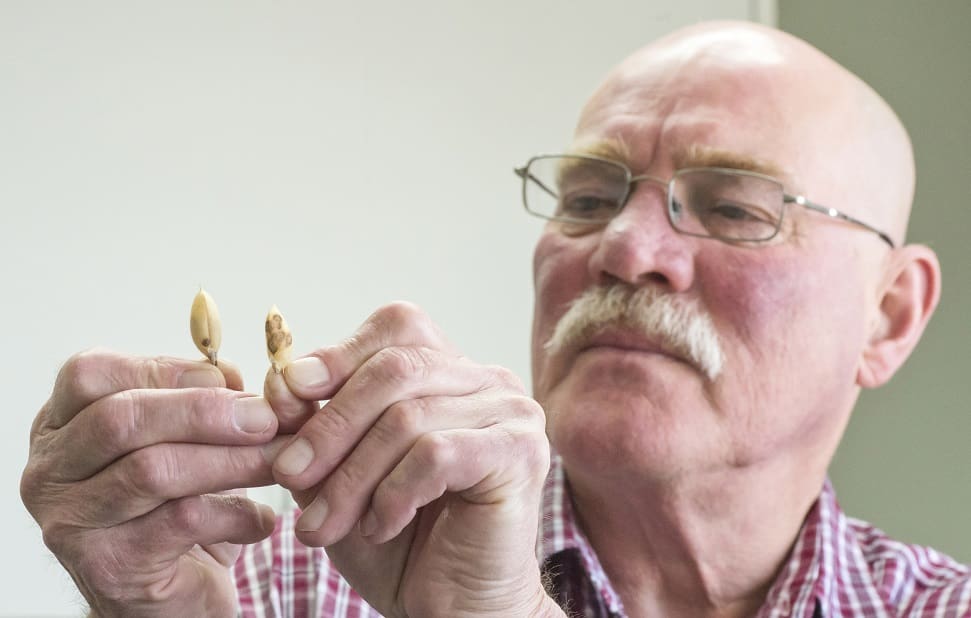
NSW DPI senior plant pathologist, Kevin Moore, is urging growers to closely monitor chickpea crops for Ascochyta blight if forecasts of a wet winter materialise.
ONE organism that has proven particularly adept at surviving the low rainfall conditions that have dogged eastern Australia over the past few years is the fungal disease Ascochyta blight.
Experts are warning of a potential widespread outbreak of the disease in chickpea crops across New South Wales and Queensland if forecasts of a wet winter materialise, due to higher than expected levels of Ascochyta blight inoculum in some paddocks.
Disease inoculum for 2020 crops may have originated as far back as 2017 or 2016 with drought slowing the breakdown of plant residues and therefore inoculum not necessarily decreasing as expected.
NSW Department of Primary Industries (DPI) senior plant pathologist Dr Kevin Moore has urged growers to closely monitor any crops planted into chickpea residue.
“Testing has shown that even though Ascochyta inoculum hasn’t increased over the past three seasons, it hasn’t decreased much either because the dry conditions have slowed the breakdown of plant tissues,” Dr Moore said.
“Disease inoculum for 2020 chickpea crops may be more than three years old so if growers can see intact chickpea stubble, they should assume that Ascochyta is viable.”
The Ascochyta pathogen survives and spreads in infected seed, stubble and on volunteer chickpea plants. Under ideal conditions, it can reproduce in as little as five to seven days and is readily spread by raindrop splash, wind, surface water flows, machinery and animals.
Assess risk level
Dr Moore said it was critical for growers to determine the risk level of individual paddocks and implement appropriate management strategies.
“High risk paddocks are those where there’s viable Ascochyta inoculum or that have been planted to chickpeas in the last three years, seed that is of unknown Ascochyta status or seed that hasn’t been properly treated with a registered seed dressing,” he said.
“Growers in high risk situations should apply a preventative fungicide before the post-emergent rain event.
“Those who are planning to plant into a high risk paddock should ensure they are growing a variety with the highest level of Ascochyta resistance suitable to the area, test seed for germination and vigour, and treat all seed with a properly-applied, registered fungicide.”
By comparison, low risk paddocks are those where no infected chickpea residue has entered the paddock via a dirty header which has previously harvested chickpeas, wind or surface water movement; no chickpeas have been grown for three years (after 2016); chickpeas weren’t grown in adjacent paddocks in 2019; seed has been tested for pathogens with nil detected; and seed has been properly treated with fungicide dressing.
“Growers planting into low risk paddocks should regularly monitor the crop throughout the season, especially 10–14 days after rain, and only apply foliar fungicide if Ascochyta is detected,” Dr Moore said.
Disease prevention is important during the reproductive stage as the disease on pods causes seed abortion, seed infection and seed defects, and may render the seed unsuitable for planting the following season.
Fungicide protection
Preventative fungicides include active ingredients such as chlorothalonil and mancozeb which provide excellent protection when applied before rain with good coverage and high water volumes as per label recommendations.
While post-infection or salvage applications should not be considered part of a grower’s standard Ascochyta management program, Dr Moore said there were two new chemical options with preventative and curative activity which could be useful in situations where a spray is missed.
“This new chemistry, which includes products such as Aviator® Xpro® (prothioconazole + bixafen) and Veritas® (tebuconazole + azoxystrobin), are registered for use on chickpeas but with very stringent conditions.
“These fungicides are much more expensive than chlorothalonil and no more effective when applied as preventatives.
“However, they may be beneficial if a grower misses a spray, providing they’re applied within 48 hours after the rain starts.”
Source: GRDC
Additional information is available in Dr Moore’s 2020 GRDC Update paper Managing chickpea diseases after the drought.
NSW DPI fact sheet: https://bit.ly/3gQf5AG

HAVE YOUR SAY